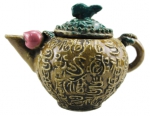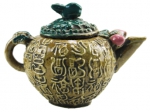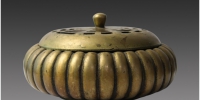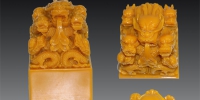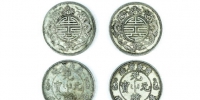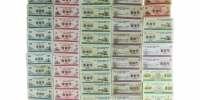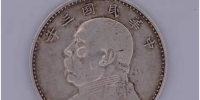四川永合利精品推荐丨(清中期)粉彩寿桃茶壶
四川永合利拍卖有限公司,为藏品强大的传播效应向各位买家推荐经国家一级鉴定专家甄选的艺术珍品 , 为藏家牵线搭桥 , 让千百件艺术珍品价值被发掘与重视 , 在拍卖会上得以高价成交。
Sichuan Yonghe Li Auction Co., Ltd. For the strong dissemination effect of collections, we recommend to buyers the art treasures selected by experts of national first-level appraisal, and make a bridge for Tibetans, so that the value of thousands of art treasures can be excavated and valued, and high-priced transactions can be concluded at auction .
【名称】粉彩寿桃茶壶(清中期)
【规格】高:10cm口径:3.6cm底径:4cm
【类别】瓷器
[Name]Pink Shoutao Teapot (Mid-Qing Dynasty)
[Specification] High: 10cm diameter: 3.6cm bottom diameter: 4cm
[Category] Porcelain
今天给各位藏友带来(清中期)粉彩寿桃茶壶,藏品来自于一位西安的姬先生,据持宝人姬先生讲解,此藏品是家传到自己手上,自己多年一直私自保存着,舍不得拿出来,这次希望通过平台给各位鉴赏。
Today, I brought you a pink longevity peach teapot from Xi'an. According to Mr. Ji, the treasure holder, this collection is handed down from home to his own hands. I have kept it for many years, and I am reluctant to take it out. This time, I hope to appreciate it through the platform.
该藏品形制规格富贵大器,外观以黄料福纹为底,粉饰描绘折枝寿桃,壶身福禄寿禧纹饰,并用描金饰边线和绿兔顶。该器从造型、规格到装饰皆在表达玉堂富贵的美意。诚然,收藏家拥有这把茶壶,平添金玉富贵之气。
The collector's shape and specifications are rich and noble. Its appearance is based on the Yellow Fuwen pattern. The decoration depicts the folded branches of Shoutao, the pot's body Fulu Shouxi pattern, and the golden border and the green rabbit top. From shape, specification to decoration, the vessel expresses the beauty of Yutang's richness. It is true that the collector owns this teapot, which adds to the wealth of gold and jade.
清代嘉庆朝生产的粉彩瓷器。从传世品看,无论是器形还是纹饰题材,都以前朝作品为蓝本,没有大的突破,尤其是嘉庆早期,乾隆太上皇健在时与乾隆朝作品基本一致,因此有“乾嘉不分”的说法。嘉庆的精品如不看款识,很容易与乾隆相混淆。嘉庆粉彩官窑款识多数在器底,为红彩或金彩或青花篆书“大清嘉庆年制”六字款,字体工整,结构严谨。值得提出的是嘉庆民窑款识,常见一种青花篆书的“大清嘉庆年制”六字款,笔画不齐,均用六字的半边字组成,草率松散,有的还不易识别。
Pink Porcelain Produced by Jiaqing Dynasty in Qing Dynasty. From the perspective of handed down works, no matter the shape or decorative theme, the works of the former dynasty were the blueprint, and there was no major breakthrough. Especially in the early Jiaqing period, Emperor Taihuangjian of Qianlong was basically the same as the works of the Qianlong Dynasty, so there was a saying that "Qianlong and Jiaqing are indiscriminate". Jiaqing's boutiques are easily confused with Qianlong's if they don't look at money. Jiaqing Pink Official Kiln is mostly at the bottom of the wares. It is a six-character style of red or gold or blue and white seal book "Jiaqing Year System of the Qing Dynasty", with neat font and rigorous structure. It is worth pointing out that Jiaqing folk kiln fund recognition, a common blue and white seal book "Qing Jiaqing Annual System" six-character paragraph, uneven strokes, are composed of six-character half-edge characters, rash and loose, and some are not easy to identify.
嘉庆前期粉彩器物的胎质基本保持乾隆中晚期较为细腻润泽的质感,至后期胎体略显粗糙,厚薄不一。此时粉彩瓷器以色地为主,不甚平整,有波浪感,白地粉彩器物相对较少,釉面细润多白中闪青,釉面较薄匀。大体前期作品釉层较为密致,后期釉面多粗松。此时官窑粉彩器物的口沿处多施以金彩、内里与器底部分常施以松石绿釉,只是色泽比乾隆时期略显深重且稍欠匀净。
In the early period of Jiaqing, the texture of the pastel utensils basically maintained a more delicate and moist texture in the middle and late period of Qianlong, but in the later period, the body was slightly rough and varied in thickness. At this time, the pastel pottery is mainly of color, not very flat, with a wave feeling. The white pastel pottery is relatively few, and the glaze is fine and moist, white and shiny blue, and the glaze is thin and even. Generally, the glaze of the earlier works is denser, and the glaze of the later works is more loose. At this time, gold, Turquoise and green glaze were often applied along the mouth, inside and bottom of the pink ware in the official kiln, but the color was slightly deeper and less uniform than that in the Qianlong period.
《陶雅》一书有云: “(清代)中叶以后,深厚故不如康熙,美丽也不及雍正,惟以不惜工本之故,犹足以容与中流。嘉(庆)、道(光)以降,画工、彩料直愈趋愈下,而极精之品,犹自有不可埋没处。”正如该书中所言,尽管嘉庆年间烧造的瓷器大不如前,但仍有许多不可埋没的佳作精品,作为历史遗留给我们的宝贵财富,应受到重视。
Tao Ya is a book with clouds: "After the middle of the Qing Dynasty, it was not as deep as Kangxi, nor as beautiful as Yongzheng, but at the cost of work, it was enough to be tolerant and middle-class. Since Jia (Qing) and Dao (Guang), painters and colours have been declining, while the most exquisite products have their own place to bury. As stated in the book, although the firing of porcelain in Jiaqing was much worse than before, there are still many excellent works which can not be buried. As a precious wealth left to us by history, we should pay attention to them.
ra
